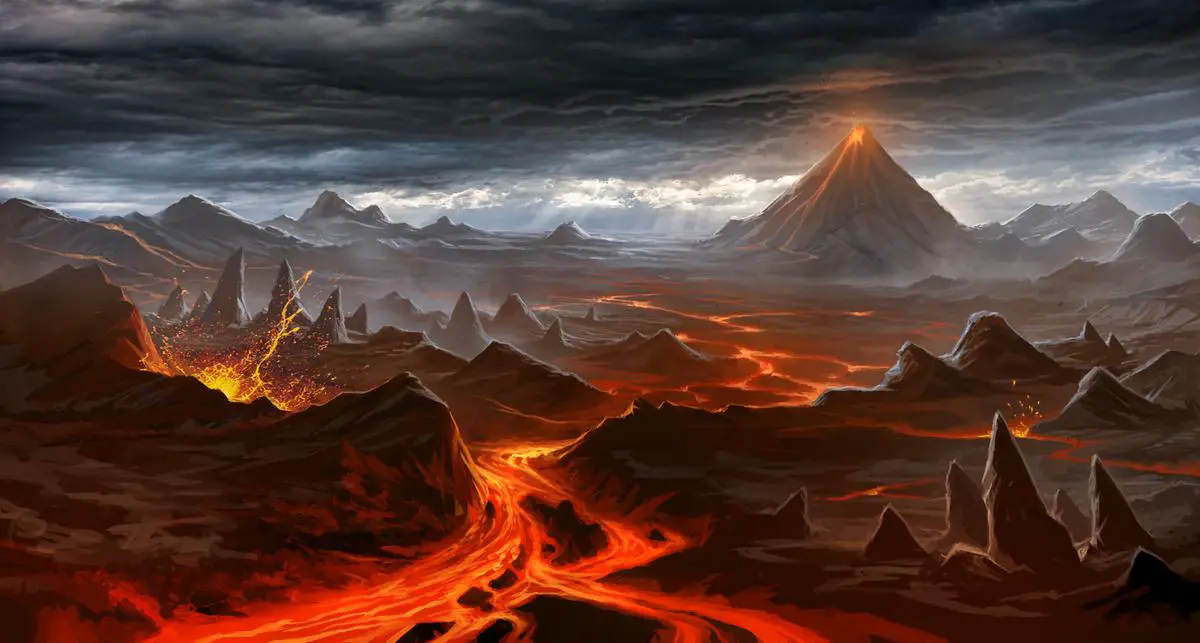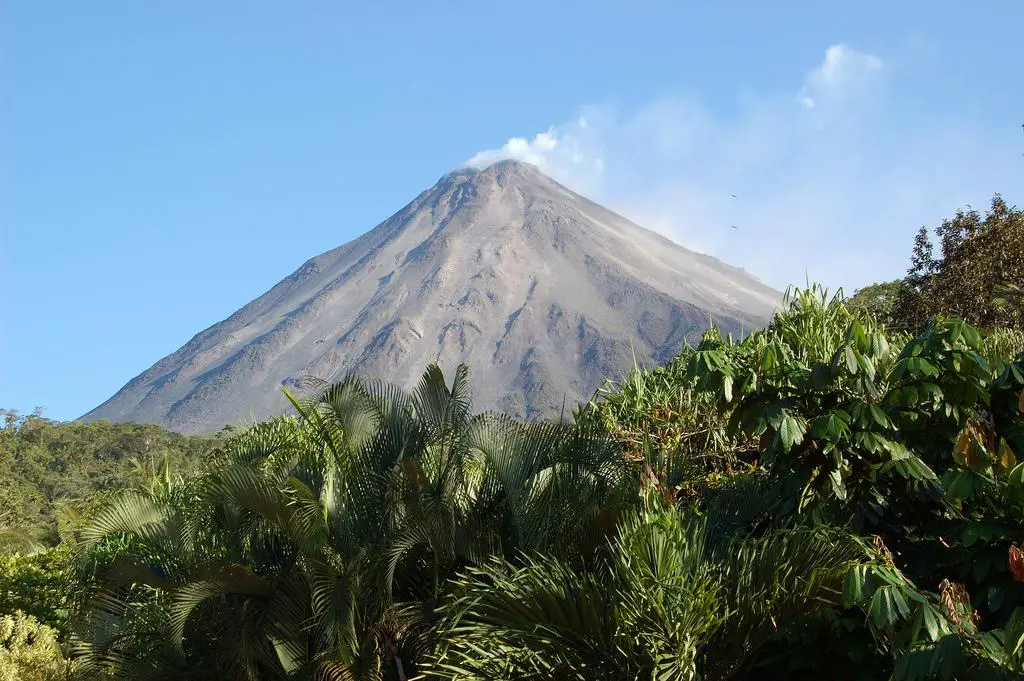Early Atmospheric Composition
Around 4.5 billion years ago, Earth's atmosphere was just starting to take shape. It was a mix of gases, vastly different from what we breathe today. Volcanic activity dominated the landscape, continuously releasing gases that would set the stage for life.
Primordial volcanic eruptions were the main contributors, filling the air with:
- Carbon dioxide
- Water vapor
- Nitrogen
- Sulfur dioxide
- Other trace gases
Unlike today's water cycle, ancient Earth saw water vapor cooling, condensing, and falling as intense rains, forming oceans and lakes.
Water vapor, one of the most abundant gases, was released continuously by volcanoes. It formed thick clouds as it cooled, then rained for long periods, filling basins to create ancient oceans. This ongoing cycle played a crucial role in moderating Earth's temperature and preparing it for future life forms.
Carbon dioxide was also prevalent. Early Earth had high levels of CO2, creating a greenhouse effect much more intense than today's. High CO2 levels caused weathering of rocks and the formation of carbonates, gradually reducing the CO2 concentration in the atmosphere.
Nitrogen, mostly emitted from volcanic eruptions, made up a significant part of early Earth's atmosphere. Being relatively inert, it accumulated over time as CO2 levels decreased through rock weathering and ocean formation.
Sulfur gases, though less abundant, also played a major role. Volcanoes emitted sulfur dioxide, forming tiny particles that could reflect sunlight away from Earth, temporarily cooling it down. These gases eventually converted into sulfates, removed from the atmosphere by rain.
Methane and ammonia, present but not dominant, came from early Earth's volcanic outgassing. They were gradually broken down by sunlight and chemical reactions with other gases and minerals in the atmosphere.
Our current air, rich in oxygen and stable in nitrogen, emerged slowly through countless volcanic eruptions that gradually balanced out gas levels over millions of years. This balance would become crucial as ancient organisms evolved to harness sunlight, carbon dioxide, and water to produce oxygen—a game-changer for life on Earth.
Understanding these early atmospheric conditions helps us piece together how Earth transitioned from a volatile planet to one teeming with life. Each volcanic eruption, every drop of rain, and all chemical reactions have contributed to creating the breathable atmosphere we rely on today.

Formation of Oceans and Atmospheric Changes
As Earth continued to cool, the thick atmosphere began to transform. The water vapor released by volcanic activity began to condense, forming immense clouds. These clouds led to an extended period of rainfall that lasted for millennia, gradually filling Earth's basins and giving birth to the ancient oceans.
The formation of oceans marked a critical turning point in Earth's geological features and atmospheric dynamics. As vast carbon sinks, the developing oceans absorbed atmospheric carbon dioxide, which reacted with minerals to form carbonates. This process significantly reduced the concentration of CO2 in the air, altering the gaseous balance of the atmosphere and diminishing Earth's greenhouse effect.
"The condensation of water vapor into liquid water helped clear the atmosphere, making it less dense and more transparent. This allowed more sunlight to reach the planet's surface, laying the groundwork for future biological processes, particularly photosynthesis."
As atmospheric conditions evolved, nitrogen became more dominant. Its stability allowed concentrations to grow, ultimately forming an atmosphere where nitrogen comprised around 78%, a composition that persists to this day.
The role of volcanic activity evolved, becoming a more regulated contributor to the planet's atmosphere. Sulfur dioxide emissions continued to form reflective sulfur particles, maintaining a delicate balance in Earth's climatic system.
The interaction between the atmosphere and emerging oceans created a feedback loop that stabilized global temperatures and atmospheric compositions. This symbiotic relationship set the stage for the appearance of more complex life forms. The continuous deposition of carbonates in the oceans and the subsequent release of oxygen by primitive photosynthetic organisms gradually sculpted an environment that became increasingly hospitable.
Understanding these ancient transformations provides valuable insight into the delicate balance required to sustain our current ecosystem. It serves as a reminder of the interwoven nature of Earth's geological and biological history—one that we must strive to protect for future generations.

Photosynthesis and Oxygenation
Approximately 2.7 billion years ago, photosynthetic organisms—ancestors of today's cyanobacteria—emerged in Earth's primordial oceans. These microscopic pioneers began utilizing sunlight to convert carbon dioxide and water into energy, with oxygen as a by-product. This process, known as photosynthesis, marked the beginning of a new epoch in Earth's atmospheric history.
Through their metabolic processes, these organisms began releasing oxygen—a gas that was initially toxic to most existing life forms. Their relentless production of oxygen gradually led to its accumulation in the oceans and eventually in the atmosphere. This oxygenation event was slow, methodical, and transformative.
The Great Oxidation Event, occurring roughly 2.4 billion years ago, was the culmination of these photosynthetic activities. As oxygen levels in the atmosphere rose, it triggered a series of complex reactions. Iron-rich rocks began to oxidize, recording the presence of this new gaseous player in Earth's atmosphere.
This era also marked the decline of the methane-dominated greenhouse effect. Methane reacted with the newly abundant oxygen, forming carbon dioxide and water. This reaction reduced methane levels, contributing to a cooling period on Earth often referred to as a "mini ice age."
Implications of Increased Atmospheric Oxygen:
- Organisms evolved ways to detoxify and utilize oxygen
- Emergence of aerobic respiration
- Support for larger and more complex life forms
- Formation of the ozone layer
As oxygen continued to accumulate, it eventually reached the upper atmosphere, forming the ozone layer. This protective shield absorbed harmful ultraviolet radiation from the sun, allowing life forms to venture out of the ocean depths and onto land.
The legacy of these ancient photosynthetic organisms is evident in every breath we take and every ounce of energy we consume. Their activities not only reshaped the atmosphere but also provided the necessary conditions for the evolution of multicellular organisms.
Understanding the role of photosynthesis and oxygenation in Earth's history offers profound insights into the interconnectedness of all life forms. It underscores the importance of protecting our environment, ensuring that the conditions that allowed life to thrive remain intact for future generations.

Atmospheric Layers and Their Characteristics
The Earth's atmosphere consists of five main layers, each with unique characteristics, temperature variations, and significance in our planet's environmental dynamics.
| Layer | Height | Key Characteristics |
|---|---|---|
| Troposphere | 0-5/9 miles (0-8/14.5 km) | Weather occurs, 75% of atmosphere's mass, temperature decreases with altitude |
| Stratosphere | Up to 31 miles (50 km) | Contains ozone layer, temperature increases with altitude |
| Mesosphere | Up to 53 miles (85 km) | Extremely low temperatures, meteors burn up here |
| Thermosphere | Up to 372 miles (600 km) | High temperatures, auroras occur, ISS orbits here |
| Exosphere | Up to 6,200 miles (10,000 km) | Transitions to space, contains primarily hydrogen and helium |
The troposphere, the lowest layer, extends from Earth's surface up to around 5 to 9 miles (8 to 14.5 km). It's where almost all weather occurs and holds about 75% of the atmosphere's mass. Temperatures in the troposphere decrease with altitude, influencing weather patterns and climate dynamics.
The stratosphere stretches up to about 31 miles (50 km) above the Earth. It's relatively stable and contains the ozone layer, which absorbs and scatters ultraviolet solar radiation. Unlike the troposphere, temperatures in the stratosphere increase with altitude due to this absorption of ultraviolet light.
The mesosphere reaches up to around 53 miles (85 km) above the Earth. Temperatures drop significantly here, often reaching lows of around -130 degrees Fahrenheit (-90 degrees Celsius). Many meteors burn up in this layer, creating streaks of light across the night sky.
The thermosphere extends up to approximately 372 miles (600 km) above the Earth's surface. Despite its name, the thermosphere's sparse air molecules wouldn't feel hot to human touch, even though temperatures rise dramatically due to the absorption of highly energetic solar radiation. The Northern and Southern Lights occur in this region, and the International Space Station orbits within this layer.
The exosphere is the outermost layer, extending from the top of the thermosphere up to about 6,200 miles (10,000 km) above the surface. It contains primarily hydrogen and helium and transitions into the vacuum of space. Satellites orbit within this zone.
The interplay between these atmospheric layers creates a dynamic system that supports and protects life on Earth. Each layer contributes to the complex phenomena that range from weather patterns to the aurora borealis, emphasizing the profound interconnectedness of Earth's atmospheric environment. Understanding the intricacies of each atmospheric layer deepens our appreciation for the delicate balance that sustains life on our planet.
Comparative Planetary Atmospheres
Comparing Earth's atmosphere to those of Venus and Mars reveals striking differences that illuminate the processes shaping planetary evolution and potential for sustaining life. Despite their proximity in the inner solar system, these three planets exhibit vastly different atmospheric conditions.
| Planet | Main Atmospheric Component | Surface Pressure | Average Surface Temperature |
|---|---|---|---|
| Venus | Carbon dioxide (96.5%) | 90 times Earth's | 900°F (475°C) |
| Mars | Carbon dioxide (95%) | <1% of Earth's | -80°F (-60°C) |
Venus's atmosphere also contains clouds of sulfuric acid and small amounts of nitrogen. The intense greenhouse effect on Venus results in its extreme surface temperatures.
Mars has traces of nitrogen, argon, and other gases in its thin atmosphere. These conditions prevent liquid water from persisting long on the surface. Evidence suggests Mars once had a thicker atmosphere and liquid water, indicating a warmer and wetter past. However, Mars's smaller size and weaker gravity failed to retain this atmosphere over billions of years. Its magnetic field weakened, allowing solar winds to strip away much of its atmospheric gases.
The varying atmospheric compositions and pressures highlight the crucial role of:
- Planetary size
- Volcanic activity
- Magnetic fields
- Water bodies
Earth's balanced interplay between these factors allowed for a stable, life-sustaining atmosphere. In contrast, Venus's thick CO2 blanket and Mars's thin, frigid envelope demonstrate the diverse outcomes possible under different planetary conditions.
Studying these planetary atmospheres expands our understanding of climate dynamics and atmospheric chemistry, providing valuable insights into Earth's past, present, and potential future. These analyses deepen our appreciation of the finely tuned balance required for habitable conditions and guide our search for life on exoplanets.
Modern Understanding and Research
Recent scientific advancements have significantly deepened our understanding of Earth's atmospheric origins. Two primary mechanisms—volcanic outgassing and contributions from cometary impacts—continue to be at the forefront of this research.
Volcanic Outgassing
Volcanic outgassing remains a central hypothesis for the formation of Earth's primitive atmosphere. Advanced techniques have allowed scientists to reconstruct atmospheric conditions from minerals embedded in ancient rock formations. Recent studies indicate that volcanic gases were not as reduced (lacking in oxygen) as previously believed. Instead, the early atmosphere may have been more similar to our present environment, containing oxidized compounds like water vapor and carbon dioxide.
"The magma contained oxidized gases, challenging the long-held belief of a methane-dominated atmosphere. This revision suggests that the atmosphere conducive to the origin of life might have been more oxygen-rich, challenging decades of theories positing a methane and ammonia-rich atmosphere."
Researchers at the NAI's New York Center for Astrobiology at Rensselaer Polytechnic Institute have reconstructed these early conditions using the oldest minerals found on Earth1.
The Role of Nitrogen
The role of nitrogen in Earth's atmosphere has also garnered significant attention. Recent research from UCLA has addressed this mystery by examining volcanic gases from deep within Earth. They discovered that a significant portion of nitrogen likely seeped into Earth's mantle from the atmosphere over the planet's history, supporting the notion that nitrogen might have persisted from the early stages of Earth's formation2.
Cometary Impacts
Cometary impacts present an equally intriguing angle of research. Modern research supports the theory that comets, colliding with early Earth, delivered substantial quantities of water and other volatile substances. This is supported by isotopic analyses showing a close match between the deuterium-to-hydrogen ratios found in Earth's water and those present in certain comets3.
Modern understanding emphasizes a more nuanced picture: Earth's early atmosphere likely resulted from a complex interplay of internal and external forces. Volcanic outgassing provided a consistent supply of essential gases, while cometary impacts introduced additional volatiles, enriching the primordial atmosphere and oceans.
These contemporary discoveries, using sophisticated techniques and collaborative research, challenge previous models and bring us closer to understanding the atmospheric alchemy that transformed Earth into a life-sustaining haven. The journey of studying Earth's atmosphere also serves as a reminder of the delicate balance that supports life on our planet.

Reflecting on Earth's atmospheric journey, it's evident that the intricate interplay of volcanic outgassing and cometary impacts has shaped the breathable air we rely on today. This delicate balance underscores the importance of preserving our environment, reminding us that the actions we take now will influence the planet for generations to come.
![]()
